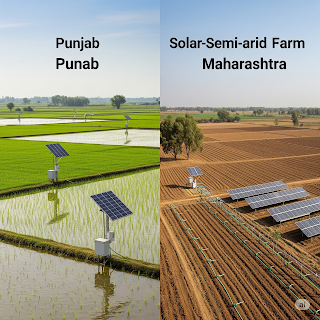India’s Solar Push Meets Regional Realities
India is aggressively expanding solar-powered irrigation as part of its green energy and climate resilience agenda. Schemes like PM-KUSUM, and state-level initiatives in Punjab, Haryana, Maharashtra, Gujarat, and others are providing farmers with subsidized solar pumps to reduce their dependence on grid electricity and diesel.
While this shift is environmentally promising, the success of solar water management isn’t one-size-fits-all. From the flood-prone fields of Punjab to the drought-ridden lands of Maharashtra, regional variation in climate, cropping patterns, groundwater availability, and policy means that each state faces unique challenges.
📍 The North-South Divide in Solar Water Management
| State | Climate | Water Status | Irrigation Mode | Solar Adoption Rate |
|---|---|---|---|---|
| Punjab | Humid subtropical | Water surplus but declining | Canal + groundwater | Low–Moderate |
| Maharashtra | Semi-arid | Water-stressed, many drought-prone zones | Borewells + tankers | High in dry belts |
Despite both states promoting solar pumps, their goals, risks, and outcomes differ sharply.
🚜 Punjab: Surplus Power, Depleting Groundwater
The Context:
Punjab has long been India’s food bowl, producing rice and wheat for national consumption. It enjoys:
-
Free power for agriculture
-
Canal irrigation support
-
High groundwater extraction (mainly for rice)
The Challenge:
Because electricity for farmers is free, there is little incentive to conserve water. When solar pumps are added to this mix:
-
Farmers may irrigate even more
-
Leads to aggravated groundwater depletion
-
Already, over 75% of Punjab’s blocks are categorized as overexploited (Central Ground Water Board, 2024)
“Solar pumps are good, but in Punjab, they could speed up groundwater collapse unless regulated,” says Dr. Rajan Bhalla, water policy expert.
Additional Hurdles:
-
Land fragmentation: Hard to scale solar solutions on small, scattered plots
-
Over-dependence on paddy: A highly water-intensive crop
-
Canal + pump duality: Often over-irrigation due to both sources
💡 Punjab: What Needs to Be Done?
-
Restrict solar pump subsidies in overexploited zones
-
Promote solar power buy-back schemes to incentivize selling electricity rather than over-pumping
-
Encourage crop diversification—millets, maize, pulses
-
Mandate drip irrigation for solar pump users
🌵 Maharashtra: Energy Scarcity Meets Water Scarcity
The Context:
In sharp contrast, Maharashtra’s Vidarbha and Marathwada regions suffer from:
-
Low and erratic rainfall
-
Frequent droughts and farmer distress
-
Inadequate grid electricity for rural farms
-
High dependence on diesel pumps or tankers
The Role of Solar:
Here, solar pumps are not just about energy efficiency—they are often the only available power source.
-
Reduce diesel costs
-
Allow irrigation in off-grid or unreliable-grid areas
-
Promote food security in dry zones
But There’s a Catch:
-
Without regulation, even solar pumping in drought-prone areas can deplete deep aquifers
-
Farmers often shift from dryland crops to cash crops like sugarcane or banana, which require more water
“The sun gives us power, but the land gives us limits,” says Vaibhav Jadhav, a cotton farmer in Beed.
💡 Maharashtra: What Needs to Be Done?
-
Prioritize solar+drip combos for cash crops
-
Use IoT-enabled sensors to limit water based on crop needs
-
Create community-level solar irrigation cooperatives instead of individual pumps
-
Integrate PM-KUSUM with Atal Bhujal Yojana for water budgeting
📖 Real-Life Comparison: Harpreet in Punjab vs. Rekha in Beed
| Factor | Harpreet (Punjab) | Rekha (Maharashtra) |
|---|---|---|
| Crops | Paddy, wheat | Cotton, pulses |
| Water Source | Canal + borewell | Borewell only |
| Energy Source | Free electricity | Previously diesel |
| Solar Pump Use | Replaces electric pump | First-time access |
| Concern | Water wastage | Borewell failure |
| Needs | Incentive to conserve water | Reliable irrigation access |
🔧 Shared Technical Challenges
Both regions also face common solar water management issues:
| Problem | Solution |
|---|---|
| 🧠 Lack of Training | Farmer workshops via Krishi Vigyan Kendras |
| 🔧 Poor Pump Maintenance | Build local solar repair technician networks |
| 📶 Weak Connectivity | Use 2G/low-band IoT tech |
| 🛰️ No Real-Time Monitoring | Introduce mobile dashboards + groundwater alerts |
🏛️ Policy Interventions Needed
Central Level:
-
Make water-sensitive solar pump eligibility criteria mandatory (exclude overexploited blocks)
-
Roll out pan-India solar power buy-back schemes
-
Provide performance-linked incentives (water use efficiency bonuses)
State Level:
-
Punjab: Promote crop diversification subsidies, limit solar in green revolution zones
-
Maharashtra: Expand solar coverage in tribal/rainfed regions, link to climate resilience programs
🌱 Future Innovations to Watch
| Innovation | Use |
|---|---|
| Smart solar pump controllers | Auto shut-off based on soil moisture |
| Water budgeting apps | Allocate water per crop and household |
| Solar-powered community tanks | Shared storage to reduce borewell dependency |
| AI-predictive irrigation models | Based on rainfall and evapotranspiration data |
🧠 Final Thoughts: One Nation, Many Water Stories
India’s solar irrigation revolution must be regionally tuned. Punjab and Maharashtra illustrate that:
-
Solar alone is not a water solution
-
Local ecology, crop patterns, farmer behavior, and water laws matter
-
Uniform policies risk unintended consequences
“To make solar water management work, India must think regionally—but act responsibly, nationally.”

No comments:
Post a Comment